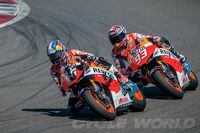Dani Pedrosa's Honda is started, he rocks it off the stand, engages first and accelerates to the droning pit-speed limit. Once he lowers his faceshield, the engine winds up effortlessly like a blender on "liquefy." It should: This 1000cc V-Four makes 240 horsepower, and the bike weighs only 350 pounds.
After Pedrosa makes the 270-degree left at the hilltop Turn 1, you hear the engine revs rise and fall as the bike corners right-left-right-left through eight bends to reach the almost 3500-foot-long straight. We can see Pedrosa's left hand move slightly for each downshift, but clutchless upshifts by the "seamless-shift" six-speed gearbox are almost imperceptible. We hear the engine give some power in the downshifts; new software this year addresses the RC213V's dislike of closed-throttle running.
Pedrosa accelerates through all six gears to more than 200 mph in 14-15 seconds, then super-hard deceleration from the carbon brakes down to first again for the left hairpin at the end, a zig and zag, followed by the long right-hander around the tower, two lefts and onto the straight again and into the pit. Everything we see—track, rider, bike—is so perfect that this could be a video-game sequence, but all of it is real.
We hear the engine idle as he rolls to a stop and the bike is “caught” by a crewman. A racing engine idles? Yes, it does. Any engine harshness disturbs traction when the bike is on the edges of its tires. Power with smoothness is the key to quick laps.





/cloudfront-us-east-1.images.arcpublishing.com/octane/URQMNYZZ6ZBM5LXGREBV3Y72OM.jpg)
/cloudfront-us-east-1.images.arcpublishing.com/octane/XH2ETEU4NVGDFNQO2XT2QQS5LU.jpg)
/cloudfront-us-east-1.images.arcpublishing.com/octane/DUGAQC2GQJCXFILEECQK2Q6T7I.jpg)
/cloudfront-us-east-1.images.arcpublishing.com/octane/4OGCCVR7WZGYDOWK4CGDTHXITA.jpg)
/cloudfront-us-east-1.images.arcpublishing.com/octane/GQV7Y6XT6FGZDIXO4P2IVJNSYE.jpg)
/cloudfront-us-east-1.images.arcpublishing.com/octane/X47GL62AXNALRHQLLBELY5WRMY.jpg)
/cloudfront-us-east-1.images.arcpublishing.com/octane/7OY2GP3FWFEDVEMDSLNGM6PZRM.jpg)
/cloudfront-us-east-1.images.arcpublishing.com/octane/Y3XYCFONBBBAHN6BWJDTWDY3FE.jpg)
/cloudfront-us-east-1.images.arcpublishing.com/octane/P3DLTISFGJA43L5QXVH7365UNY.jpg)
/cloudfront-us-east-1.images.arcpublishing.com/octane/H6FFG4YQMREO3DTADIJMECNS7Y.jpg)
/cloudfront-us-east-1.images.arcpublishing.com/octane/QCUUDRRAIFHDDGB5OTZVKUS554.jpg)
/cloudfront-us-east-1.images.arcpublishing.com/octane/RBDRR2OHFFBPRNXW6V3FN2SNAM.jpg)
/cloudfront-us-east-1.images.arcpublishing.com/octane/EFFSPCZVBBCMTNGVEQMB7NNKIU.jpg)
/cloudfront-us-east-1.images.arcpublishing.com/octane/5GP3PUGFKVGUVCEYG4ZBDYLNBE.jpg)
/cloudfront-us-east-1.images.arcpublishing.com/octane/USTSFGXT3ZGL7BT7B66WMSSKTI.jpg)
/cloudfront-us-east-1.images.arcpublishing.com/octane/Z7YU6FSR6NEKVMKT5CZPMKIVLE.jpg)
/cloudfront-us-east-1.images.arcpublishing.com/octane/MOP35BTV3FFANFBUJKU2RJRTZ4.jpg)
/cloudfront-us-east-1.images.arcpublishing.com/octane/UWTN4NTIJFD25MPXBOVS4DFOXE.jpg)
/cloudfront-us-east-1.images.arcpublishing.com/octane/SIFOY54XMFGEHAUYNFUYVW7IZ4.jpg)
/cloudfront-us-east-1.images.arcpublishing.com/octane/HMC5X3JZHRASXGVCVNBJBWWGSI.jpg)